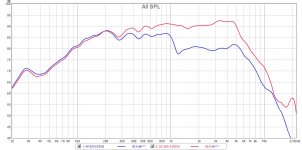Foam core enclosures might work well to minimize panel vibration decay, but the low mass can not do much to attenuate the inside the box sound to be heard from the outside, so will these have a ”boxy” coloration?
Foamcore actually has less of a boxy sound than BB or MDF if walls are untreated. It naturally absorbs sound and less reflective. With added foam or felt padding it is very good sounding. This is my experience based on listening and measurements after building hundreds of foamcore speakers.
Wow that is cool, i must to try this for my self! i really do not like carpeting wooden enclosures so it would be great if these would work for me too 🙂
As far back as 1958, Gilbert Briggs stated that expanded polystyrene does not produce the panel resonance associated with wood and other materials, being in a way acoustically 'dead'.
As Celef I was asking myself for long wave lengths (bass) ?
If the foam is very well suited for inside and outside of the cabinet, will it be even better in a spring mass spring scenario ? So for illustration foam/chip-board/foam - driver being tied on the foam or the chip-board ?
My guess is the bass being more energized may pass through the foam for a part ?
If the foam is very well suited for inside and outside of the cabinet, will it be even better in a spring mass spring scenario ? So for illustration foam/chip-board/foam - driver being tied on the foam or the chip-board ?
My guess is the bass being more energized may pass through the foam for a part ?
As far back as 1958, Gilbert Briggs stated that expanded polystyrene does not produce the panel resonance associated with wood and other materials, being in a way acoustically 'dead'.
That sounds logical, but how about sound transmission, did briggs say anything about that?
The buyout HP-5210 just isn't going to work - it has a -6dB sharp negative drop-off then level again at aobut 1000Hz - a critical audibility range for the human ear. I tried both drivers and same issue. So I switched it out to a currently still in production Dayton DC130A-8 treated paper cone, rubber surround woofer that I have used successfully on other projects. Much better - and will allow this design to be replicated if anyone chooses. Here are measurements on tweeter axis and mic (UMIK-1 calibrated by Crossspectrum Labs) at 0.5m and 2.0Vrms, data presented with 6-cycle frequency dependent window (FDW) turned on to reduce effects of room reflections. So I will proceed with the DC130A-8 - the cutout and bolt pattern and frame are exactly the same.

Attachments
Last edited:
That sounds logical, but how about sound transmission, did briggs say anything about that?
A plain panel of foamcore or XPS will re-radiate sound more efficiently than thick plywood. You can find out lots of details on this in the DML speaker thread where people WANT the sound transmission. Certain thinner plywoods actually are better at re-radiating the sound from an exciter transducer.
If you sandwich the panels with a soft non hardening glue like latex caulking or construction adhesive, it will form a constrained layer damping (CLD) and reduce the the sound transmission. Similarly, adding mass loaded butyl sheets covered in stiff aluminum foil does wonders to deaden the panel. I have done so on the larger areas here. The transmitted sound is reduced significantly. It’s not a problem when -30dB or so below the main output.
Briggs fitted polystyrene diaphragms across the cone face of certain 12" woofers. http://ukhhsoc.torrens.org/makers/Wharfedale/Booklet/Page07.gifThat sounds logical, but how about sound transmission, did briggs say anything about that?
The polystyrene, he said, acts like an acoustic filter to reduce enclosure resonances heard through the cone.
He investigated the transmission of sound through two grades of polystyrene used in the speaker diaphragms and concluded that the lighter density grade produced the most absorption.
He also concluded that the lighter density polystyrene was preferable for use as a sandwich in non-resonant panels.
Don't know if the above is of any significance to the present discussion, but it is what Briggs had to say! 🙂
Hey X, what do you think of the idea of using thicker pink (dense) styrofoam for a small cabinet, 1" thick or 2 x .75" layers?
That will work great - it just adds bulk because the internal volume needs to be preserved. It will change the baffle width somewhat if the internal width is already too small. For the LS3/5A above, I still have an extra 1/2in on each side but just barely. So the depth of the box will have to grow accordingly to preserve the volume. XPS also comes in 1/2in I think.
It’s very stiff and lightweight and makes an excellent speaker box. In fact, my XPS boxes with a 3/16in luan ply facing for the driver mounts measured just as well, as 3/4in BB ply fully treated with Noico and acoustic foam liner. And it weighs ounces vs tens of pounds.
If you look at the baffle you can see there is still 0.5in to 0.75 in that this can grow internally before getting too close to the driver basket.
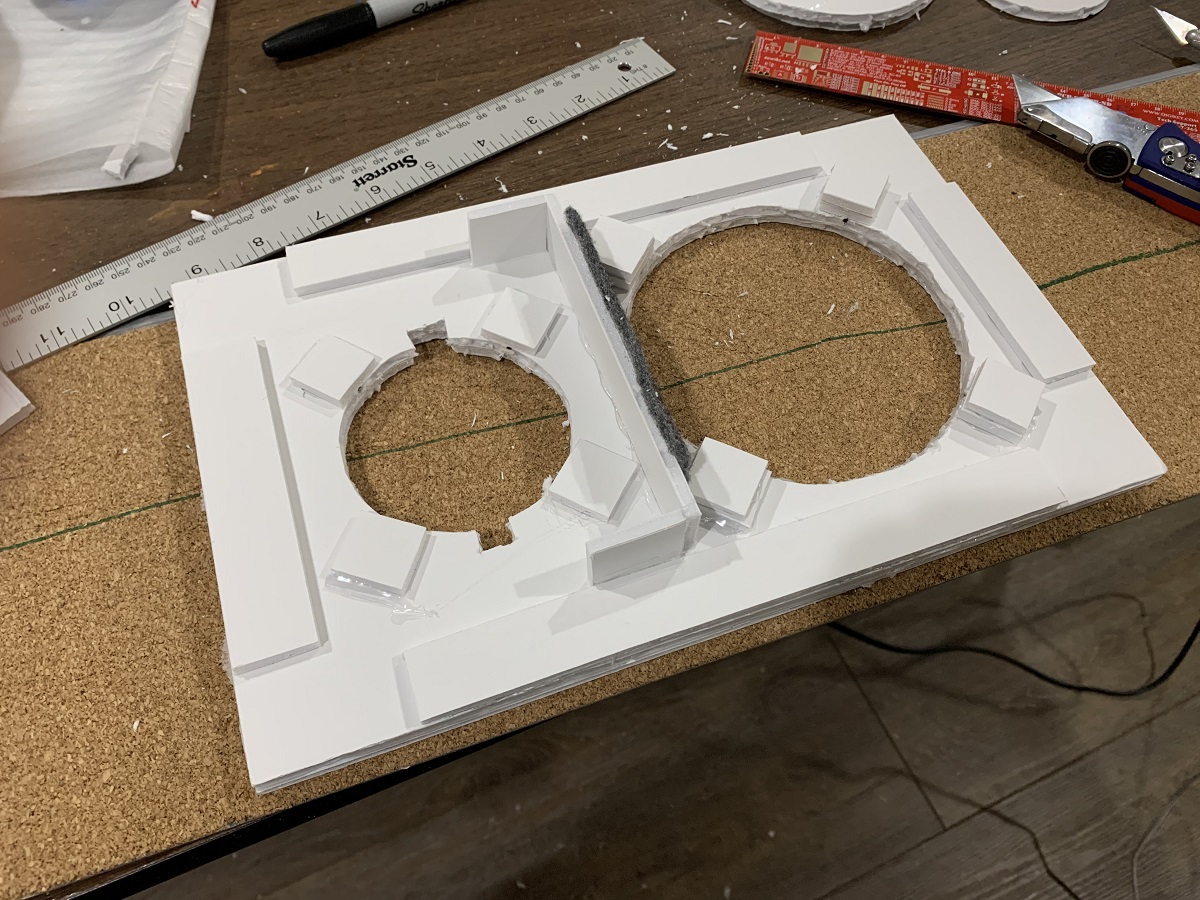
It’s very stiff and lightweight and makes an excellent speaker box. In fact, my XPS boxes with a 3/16in luan ply facing for the driver mounts measured just as well, as 3/4in BB ply fully treated with Noico and acoustic foam liner. And it weighs ounces vs tens of pounds.
If you look at the baffle you can see there is still 0.5in to 0.75 in that this can grow internally before getting too close to the driver basket.
Here is the data for XPS vs BB treated with the works.
10F/8424 & RS225-8 FAST / WAW Ref Monitor
1in thick XPS with luan ply facing on baffle:

3/4in BB with Noico foil faced butyl lining and eggcrate foam:
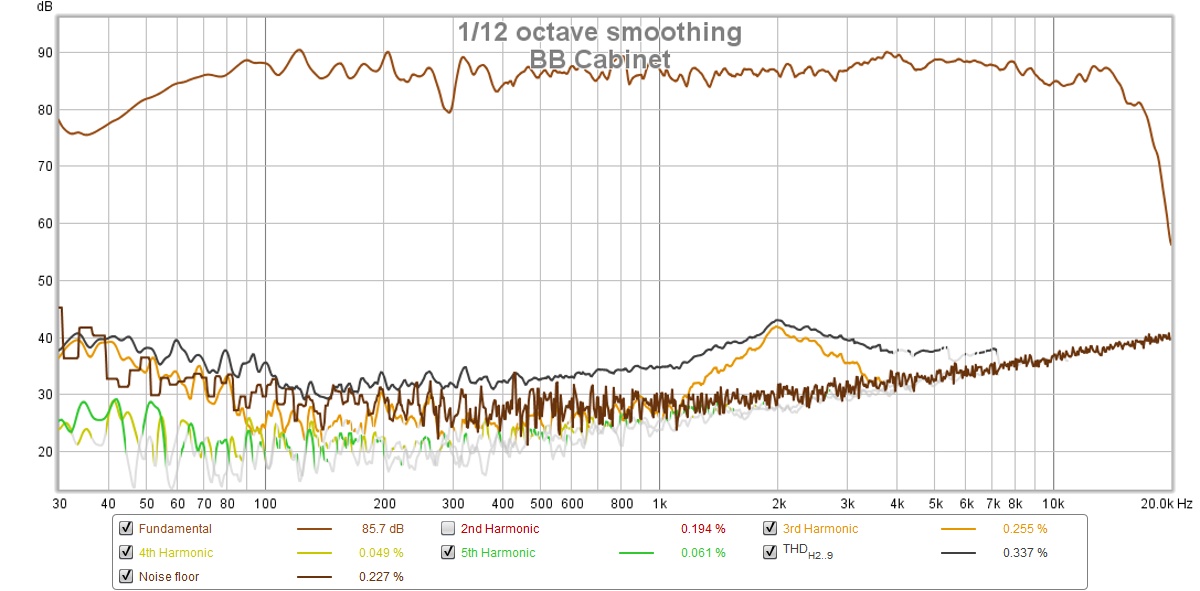
Looks wise, the BB ply gets my vote:
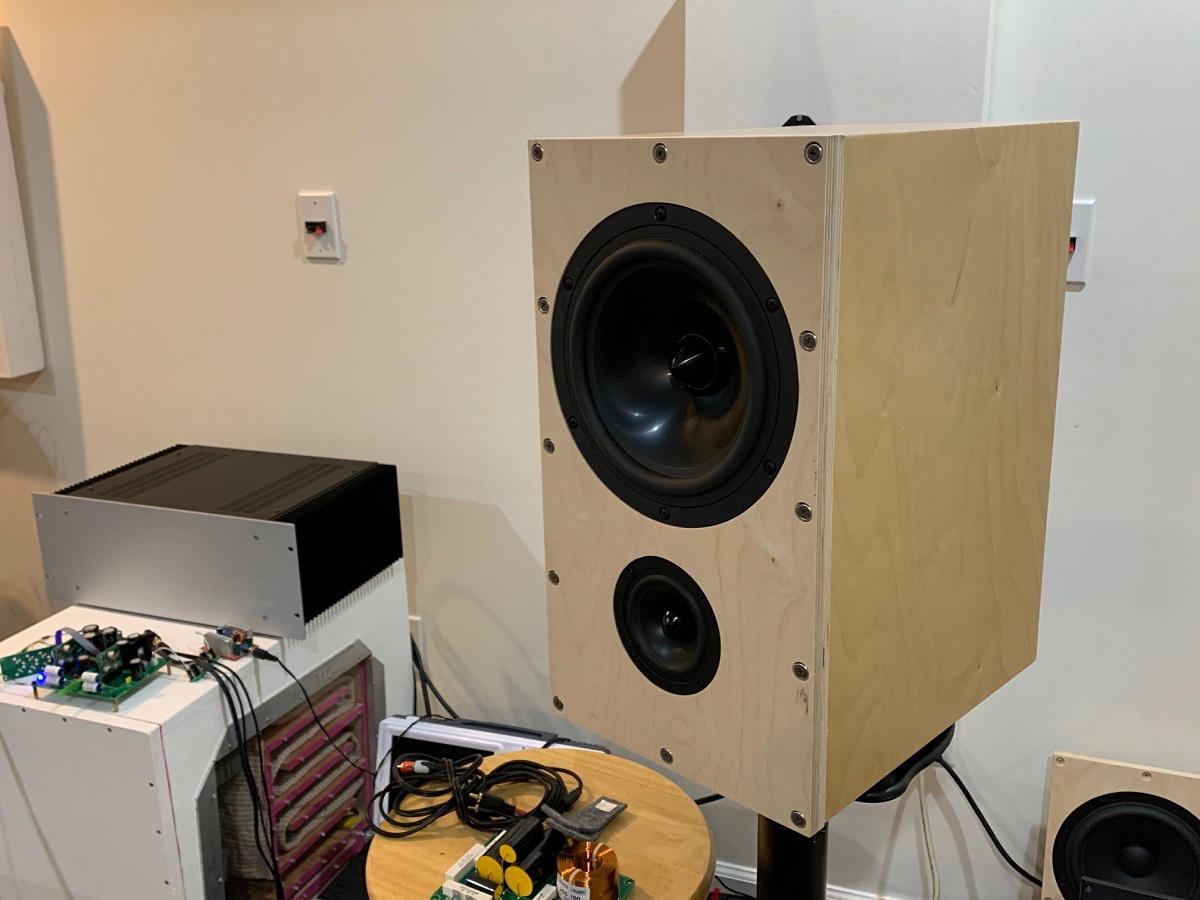
XPS with luan ply facing:

10F/8424 & RS225-8 FAST / WAW Ref Monitor
1in thick XPS with luan ply facing on baffle:
3/4in BB with Noico foil faced butyl lining and eggcrate foam:
Looks wise, the BB ply gets my vote:
XPS with luan ply facing:

I don't think your Homage to the LS3/5A hits the spot at all, xrk971. Sorry. 😀
We want a 5" polycone (no nasty breakups) and a 3/4" mylar tweeter (livelier than 1"). This gets close in some respects (except crossover).
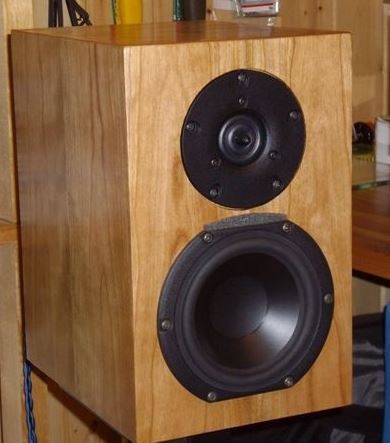
Peerless HDS PPB 830860
As you showed in another post, BBC LS3/5a loudspeaker Stirling Measurements | Stereophile.com
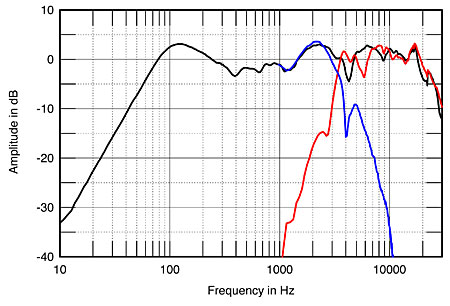
That is BW3 third order with 90 degree phase. You can spot it from the -3dB crossover point. Not phase-aligned -6dB LR2 or LR4 at all.
The original LS3/5A crosssover:
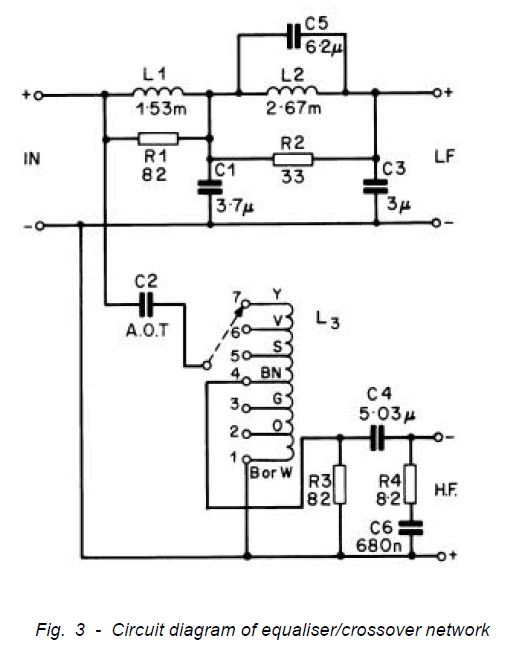
Many subtleties there. The grille cloth. The cabinet. The recessed bass, the negative polarity. A terrific speaker for voices. What it did well was flat power response in the midrange, even if slightly inaccurate on frequency response.
I think I must be the only person here who understands the difference between power response and frequency response. TBH, I'd do it MTM if I spent time on it. Just better. I could go into how BW3 fills the LR2 and LR4 power hole at crossover if you are interested.
We want a 5" polycone (no nasty breakups) and a 3/4" mylar tweeter (livelier than 1"). This gets close in some respects (except crossover).
Peerless HDS PPB 830860
As you showed in another post, BBC LS3/5a loudspeaker Stirling Measurements | Stereophile.com

That is BW3 third order with 90 degree phase. You can spot it from the -3dB crossover point. Not phase-aligned -6dB LR2 or LR4 at all.
The original LS3/5A crosssover:
Many subtleties there. The grille cloth. The cabinet. The recessed bass, the negative polarity. A terrific speaker for voices. What it did well was flat power response in the midrange, even if slightly inaccurate on frequency response.
I think I must be the only person here who understands the difference between power response and frequency response. TBH, I'd do it MTM if I spent time on it. Just better. I could go into how BW3 fills the LR2 and LR4 power hole at crossover if you are interested.
Last edited:
Hi System7,
Thanks for your comments and I will look into tryin a BW3 in future designs and see how the power response of the midrange is improved.
I am not sure if you are referring to my attempt - but I was not using LR2 or LR4 at all - I am not even sure what it is but it is asymmetric. It sort of looks like a passive Harsch (4th order LP and 2nd order HP) - but not quite textbook. There is the slight dip at 3.9kHz in the combined response to the left of the XO (typical of Harsch XO behavior), which puts it fortuitously close to the 3.5kHz "BBC dip".
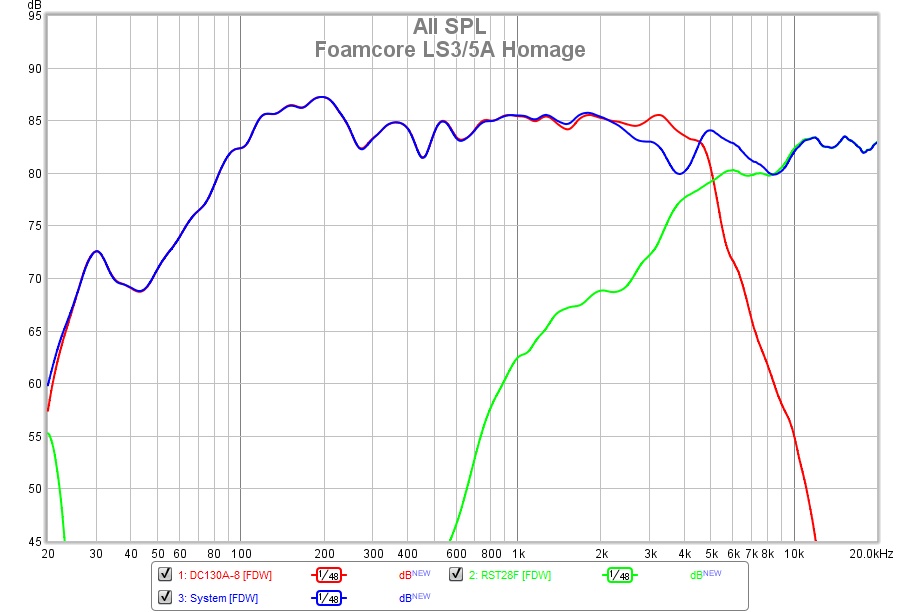
The DC130A doesn't have nasty breakup either. Here is the raw response of the DC130A vs a cheap polycone (which I could not use due to the steep drop at 1kHz). But pretty smooth falloff.
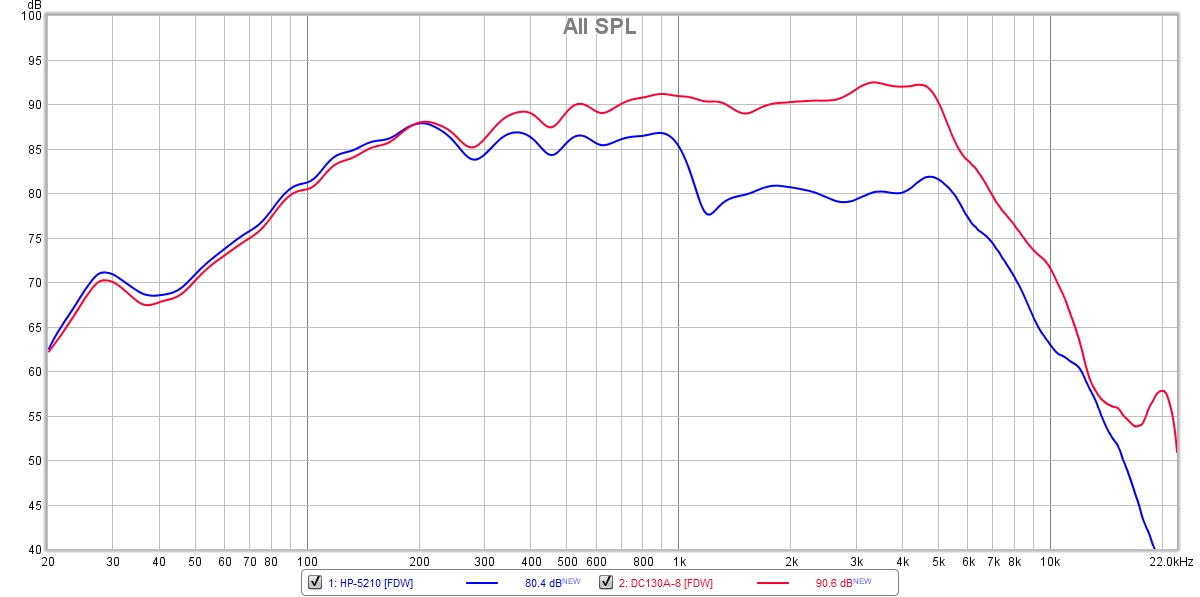
Sure, I am not going to try to clone the exact physical diffraction effects of a cabinet with a raised square edged lip (bad IMO), and I don't like cloth grills. I have tried the anti-diffraction foam around the tweeter and that does smooth things out a bit. Recessed woofer would have been a pain in foamcore as it would mean a removable front baffle which would negate the speedy build of hot melt and foam core.
Thanks for your comments and I will look into tryin a BW3 in future designs and see how the power response of the midrange is improved.
That is BW3 third order with 90 degree phase. You can spot it from the -3dB crossover point. Not phase-aligned -6dB LR2 or LR4 at all.
I am not sure if you are referring to my attempt - but I was not using LR2 or LR4 at all - I am not even sure what it is but it is asymmetric. It sort of looks like a passive Harsch (4th order LP and 2nd order HP) - but not quite textbook. There is the slight dip at 3.9kHz in the combined response to the left of the XO (typical of Harsch XO behavior), which puts it fortuitously close to the 3.5kHz "BBC dip".
The DC130A doesn't have nasty breakup either. Here is the raw response of the DC130A vs a cheap polycone (which I could not use due to the steep drop at 1kHz). But pretty smooth falloff.
Many subtleties there. The grille cloth. The cabinet. The recessed bass, the negative polarity.
Sure, I am not going to try to clone the exact physical diffraction effects of a cabinet with a raised square edged lip (bad IMO), and I don't like cloth grills. I have tried the anti-diffraction foam around the tweeter and that does smooth things out a bit. Recessed woofer would have been a pain in foamcore as it would mean a removable front baffle which would negate the speedy build of hot melt and foam core.
Last edited:
I have heard the 135tc and the 135AD. They are quite similar, the AD has a slightly bigger peak about 7k and certainly run full range it can be yeard. The tc is less sensitive at 8ohm which might or might not be an issue. A driver that looks very promising that I have not heard is the Monacor sph 130. This has very similar specs to the kef B110, but looks much less peaky.
After your sugestion I think I am going to go with the 130 driver next. Quite pleased overall with the 135TC results but it'll be nice to try another in the next build.
Any recommendations for a tweeter to match? I think I'll try a metal this time.
Maybe this
H0532-08 19TAFD/G
Harbeth P3 had good results with it I think, but I never heard those, might be a good match up for the 130. Anyone know what type of tweeter is in the new P3ESR?
Or another which many seem to love is
H1212-06 27TBFC/G
Member
Joined 2009
Paid Member
Many subtleties there. The grille cloth. The cabinet. The recessed bass, the negative polarity. A terrific speaker for voices. What it did well was flat power response in the midrange, even if slightly inaccurate on frequency response.
I think I must be the only person here who understands the difference between power response and frequency response. TBH, I'd do it MTM if I spent time on it. Just better. I could go into how BW3 fills the LR2 and LR4 power hole at crossover if you are interested.
Doesn't BW3 produce some less desirable results off-axis when path lengths result in tweet and woof relative phase becoming additive - the increased power output there can give some harshness in live rooms whereas original BBC maybe in a studio which was treated to minimize this ?????
It would be interesting to know how much of the sound of the Ls3/5a is down to the dead cabinet, rather than the drivers. In listening tests the versions with a screwed on back sounded better than the glued on back. One thing that I'm not sure of is transformers or inductors ( mounted on a flexible back panel ) so close to the vibrating bass driver magnet mounted to a flexible, " soft mounted front panel. I thought about making clones myself but ended up copying the ( screwed on back ) cabinets and using poly cone full range drivers.
After your sugestion I think I am going to go with the 130 driver next. Quite pleased overall with the 135TC results but it'll be nice to try another in the next build.
Any recommendations for a tweeter to match? I think I'll try a metal this time.
Sorry, I have no tweeter suggestions.
- Home
- Loudspeakers
- Multi-Way
- What's the best 5 inch driver for a small sealed box same as the LS3/5A. SPH-135TC ?
